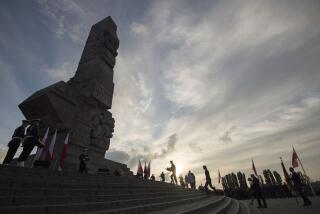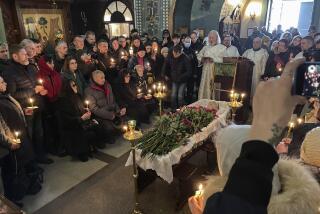Still No Rest For Romanovs Long After the Burial
- Share via
YEKATERINBURG, Russia — Every day, Nina Ignatiyevna herds her cows past a watery pit beside a stand of birch trees. The hole--which seethes with mosquitoes in summer and hunkers under ice in winter--has been marked only by a cast-iron cross.
The spot is visited by many more cows than people, she says. And even the cows find it unappealing.
“I’ve herded my cows here for 10 years,” says the shepherdess, who identified herself in traditional Russian style using her first and middle names. “They’ve never drunk the water. I could never understand why. Maybe God himself told them not to drink here.”
It was eight years ago this month that scientists excavated nine acid-charred skeletons from the pit, eventually identifying them as belonging to Russia’s last czar, Nicholas II, his wife, three of their five children and four servants. A black marble cross was unveiled at the site Friday.
It was one year ago today that Russia buried the bones with pomp and acrimony in the imperial crypt in St. Petersburg. The ceremony, presided over by President Boris N. Yeltsin, laid to rest the skeletons--but not the controversy they stirred.
“Passions around the Romanovs are still running high,” says Vladimir N. Solovyov, the government investigator who is working on the case.
Scientists agree that repeated independent DNA tests in Russia, Britain and the United States firmly identified the bones as belonging to the last of the Romanovs--the dynasty that ruled Russia for 300 years and was deposed by the 1917 Bolshevik Revolution. And Solovyov says he has made progress in the past year in tying up a few loose ends. For instance, he says two unidentified teeth found in the pit have been matched to one of the recovered skulls, which belongs to Anastasia, the czar’s youngest daughter.
But he has not come significantly closer to solving the central remaining mystery: What happened to the corpses of the other two children, Alexei and his sister Marie?
“We’re still looking for the other two,” says Alexander N. Avdonin, one of two sleuths who discovered the bones in 1979. “The fact that they are missing has made everything more complicated.”
A few miles from Nina Ignatiyevna’s pasture, Avdonin has used string to mark off sections of woodland and is meticulously sifting the soil. This second hole, called Ganina Yama, is where the royal family was buried for a day before their executioners, fearing discovery, dug them up and carried them a few miles farther to the watery pit.
According to accounts by the executioners, the two smallest corpses were burned to ash at the final grave site and scattered. The rest of the bodies were buried quickly and doused with acid so they would be unrecognizable.
Some Russian exile groups dispute this explanation. For one thing, they don’t accept evidence of any kind from Soviet sources, including the murderers’ accounts. Their dissent persuaded the Russian Orthodox Church to withhold its recognition of last year’s burial and fuels a thriving industry in Romanov escape stories.
“The remains of those buried remain unidentified,” asserts Vadim A. Viner, president of the Center for Investigation of the Circumstances of the Romanovs’ Murder, an institute in Yekaterinburg dedicated to disproving the government version. “Doubts about their identity have never disappeared. In fact, over the years they have only grown more numerous and potent.”
Avdonin wants to prove them wrong. In the past year he has turned up some new bone fragments and is trying to determine if they are human.
Solovyov hopes the fragments will help “dot the I’s and cross the T’s” in the investigation. Meanwhile, he is still trying to locate a box of evidence collected at Ganina Yama by Nikolai Sokolov, a monarchist investigator who discovered the site in 1919.
The box, which is rumored to hold a bejeweled finger along with other items, is believed to be in safekeeping in an Orthodox church in Belgium. But church officials have refused Solovyov access.
“The church has remained unbending,” he says.
Romanov descendant Grand Duchess Leonida Georgiyevna boycotted the funeral and promotes her grandson as heir to the Russian throne. From her home in Paris, she says that as long as the church dissents, so will she.
“I think it may take a long, long time,” she says. “Time is not a factor when we are seeking the truth.”
More to Read
Sign up for Essential California
The most important California stories and recommendations in your inbox every morning.
You may occasionally receive promotional content from the Los Angeles Times.













